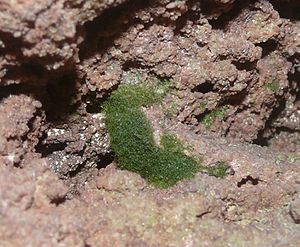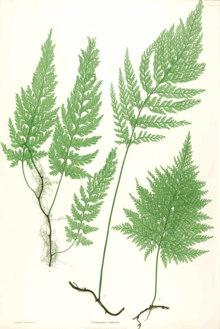Magnificent thin fern
| Magnificent thin fern | ||||||||||||
|---|---|---|---|---|---|---|---|---|---|---|---|---|

Gametophytes of the magnificent thin fern in a crevice |
||||||||||||
| Systematics | ||||||||||||
|
||||||||||||
| Scientific name | ||||||||||||
| Trichomanes speciosum | ||||||||||||
| Willd. |
The Magnificent Dünnfarn ( Trichomanes speciosum ) is a plant from the genus thin ferns ( Trichomanes ) within the family of hymenophyllaceae (Hymenophyllaceae).
Life cycle
As is typical for ferns, in the course of a generation change there is also a successive haploid , sexually reproducing generation, called gametophyte , and a diploid generation, called sporophyte , which propagates asexually via spores , whereby the sporophyte is typical for all higher plants , larger and more morphologically differentiated. Is unique among European unusual and fern species in this type but that the gametophyte, in addition to sexual reproduction, also on Gemmae called Brutkörperchen can reproduce asexually also alternatively. In this case, a gametophyte is immediately followed by another gametophyte. Since gametophytes and sporophytes also differ in their ecological demands, there are regions of the distribution area in which only gametophytes occur without ever developing the typical fern fronds (the sporophyte generation). These can be hundreds of kilometers away from sporophyte occurrences in Europe. The distribution area of the gametophyte is much larger in this species than that in which sporophytes are also formed.
description
Gametophyte
The gametophyte of the fern grows as a felty, mat or cushion-like bed made of branched cell threads. The individual cells are around 150 to 300 micrometers long and 40 to 55 micrometers wide. They are freshly colored green, but take on a blue-green color when they dry out. They can vary from single filaments, often between moss plants, to mats of several square meters. The cushions are quite stable and have the consistency of wool when touched. They can be distinguished by this and by the stronger threads of protonemae from mosses. They are anchored to the substrate with brown-colored rhizoids . The short-threaded gems, consisting of a few cells, sit in clusters on special structures called gemmifer. In Europe they are easily distinguishable from the gametophytes of other ferns by their filamentous habit.
Sporophyte
The sporophyte of the magnificent thin fern grows as a perennial herbaceous plant and reaches heights of up to 45 centimeters. The fronds arise individually, long, thin creeping shoots ( rhizomes ) that creep on the surface and are covered by black-colored, hair-like scales. The rhizomes reach about 2 to 4 millimeters in diameter, they often branch out, so that extensive, extensive colonies can develop from individual fern fronds. The individual fronds reach a height of about (10-) 20 to 45 centimeters, their blade is triangular-ovate to ovate-lanceolate in outline (such narrow forms were described from Ireland as var andrewsii Newm.) And about two-thirds longer to as long as its stem, at least winged upwards. The finely ruffled blade is two to three (up to four times) pinnate, with blunt (rarely pointed) tips. The actual lamina is very thin (only a single layer of cells is thick) and translucent. The feathering is symmetrical, not asymmetrical as in the genus Hymenophyllum . The conspicuous vein extends to the tip of the single lobes and pinnae. The sporangia sit on the edge of the spreading in cup- or tube-like sori on a central, bristle-shaped axis that protrudes hair-like from the two-lipped indusium ; These bristle hairs are still clearly recognizable on older Sori.
The fronds of the fern are slow-growing and evergreen, sterile fronds can live for several years.
The chromosome set is 2n = 144.
distribution
The distribution area in which sporophytes of the magnificent thin fern were registered is limited to the Macaronesian archipelago and a few relic occurrences of the coastal Atlantic Western Europe, it includes the Cape Verde Islands , the Azores , the Canary Islands , Madeira , the south, west and north-west of the Iberian Peninsula (with the southernmost occurrence in the Aljibe Mountains immediately north of Gibraltar), the Basque Country and the Armorican Massif in western France, Ireland (especially the southwest of the island, County Kerry ) and a few isolated outposts in the west of Great Britain and Italy. Within this area, the species is usually restricted to a few special locations and rare everywhere, so that it is counted among the rarest European fern species.
For the first time in 1992 in the French Massif Central it was surprisingly found that the gametophyte of this fern species is much more widespread and occurs far to the east, especially in Europe. When botanists started a targeted search, the species was found in 1993 in the Vosges, Luxembourg and the southern Palatinate in Germany. Later it was registered further east, for example in the Elbe Sandstone Mountains (both on the German and the Czech side). The easternmost known sites are two sites found in 2002 in the Sudetes in the extreme west of Poland. The gametophyte is also more common in the distribution area of the sporophytes, it is found in Italy from Liguria to Tuscany and more widely in Great Britain, to the east of Scotland.
Finds of gametophytes from Germany until 1998 are known from the Palatinate Forest, the Eifel, the Bergisches Land (Devil's Cliffs near Solingen), the Northern Black Forest, the Spessart, the Elbe Sandstone Mountains and the Zittau Mountains, always on sandstone cliffs, almost entirely of the Buntsandstein . Since then, a number of other occurrences have been discovered, for example in southern Lower Saxony ( Reinhäuser Wald ) or in the Hessian Odenwald, Taunus, Burgwald and Werraland. A distribution map for Germany (as of 2013) is given at Floraweb. With the exception of a few millimeters long specimens in the Palatinate Forest, sporophytes have never been detected in Germany.
Ecology and location
The species grows on rocky sites on acidic (rarely neutral) rock, often sandstone, in humid, shady locations, often in the entrance area of caves or rock overhangs or in the splash area of waterfalls, often in dark, little exposed areas, mostly within forest areas. In Andalusia it reaches 500 to 700 meters above sea level. It is absent in exposed locations with the influence of wind and on limestone. Only in Macaronesia are there semi- epiphytic occurrences on mossy tree trunks.
natural reserve
The species is species of community interest according to Appendix II and Appendix IV of the Habitats Directive of the European Union and listed in Appendix I of the Bern Convention . This means that the states of the EU should designate special protected areas for the fern as part of the Natura 2000 network of protected areas , but also that all occurrences outside of protected areas are subject to special species protection.
According to the IUCN's assessment , the species is considered to be harmless (least concern), but attention is drawn to threats due to the special location requirements and slow growth, so that the population development should be examined further. Influences of forestry, leisure activities (e.g. climbing), but also gathering by botanists and plant lovers are given as threat factors.
In the 19th century, in the Victorian era , the species was in great demand in England due to its rarity in collections and greenhouses of wealthy Englishmen, and their possession was considered a status symbol. Most of the English deposits were therefore plundered for the plant trade during this period.
Taxonomy
Trichomanes speciosum was first published in 1810 by Carl Ludwig Willdenow . The first finds, made by Richard Richardson in Yorkshire, England, date back to 1724, but were mistakenly assigned to the (tropically widespread) Trichomanes radicans (now Vandenboschia radicans ).
Recent genetic studies have shown that the species-rich genus Trichomanes, comprising more than 250 species, is polyphyletic in the traditional definition and must be abandoned. The splendid thin fern belongs to a clade that is now included as an independent genus Vandenboschia Copeland. This was traditionally understood as a sub-genus of Trichomanes , with a slightly different description . Within the genus, it belongs to the subgenus Vandenboschia s , along with around 15 other species . st. on. The species should therefore be referred to as Vandenboschia speciosa (Willd.) G. Kunkel today, but is still listed under the traditional name in most of the flora books.
Individual evidence
- ^ A b c d FJ Rumsey, AC Jermy (1998): The independent gametophytic stage of Trichomanes speciosum Willd. (Hymenophyllaceae), the Killarney Fern and its distribution in the British Isles. Walsonia 22: 1-19.
- ↑ a b c CN Page: The Ferns of Britain and Ireland. Cambridge University Press, 2nd edition 1997. ISBN 0-521-58380-2 . Pp. 375-380.
- ↑ Clive Stace: New Flora of the British Isles. Cambridge University Press, 3rd edition 2010. ISBN 978-1-139-48649-1 . P. 16.
- ↑ DA Webb: Trichomanes L. in TG Tutin, NA Burges, JR Edmondson, AO Chater, VH Heywood, DM Moore, JR Akeroyd, DH Valentine, SM Walters, RR Mill, DA Webb, ME Newton (editors): Flora Europaea. Vol. 1: Psilotaceae to Platanaceae. Cambridge University Press, 2nd edition 1995. ISBN 0-521-41007-X . P. 15
- ↑ M. Laínz: Vandenboschia. In: S. Castroviejo, M. Laínz, G. López González, P. Montserrat, F. Muñoz Garmendia, J. Paiva, L. Villar (editors): Flora Iberica. Plantas vasculares de la Península Ibérica e Islas Baleares. Vol. 1: Lycopodiaceae-Papaveraceae. Real Jardín Botánico, Madrid, 1986. ISBN 84-00-06221-3 . Pp. 73-74.
- ↑ Samira Ben-Menni Schuler, María del Carmen García-López, Inmaculada López-Flores, Marta Nieto-Lugilde, Víctor N. Suárez-Santiago (2017): Genetic diversity and population history of the Killarney fern, Vandenboschia speciosa (Hymenophyllaceae), at its southern distribution limit in continental Europe. Botanical Journal of the Linnean Society 183: 94-105.
- ↑ a b S. Loriot, S. Magnanon, E. Deslandes (2006): Trichomanes speciosum (Hymenophyllaceae, Pteridophyta) in northwestern France. Fern Gazette 17 (6-8): 265-281.
- ↑ a b Helga Rasbach, Kurt Rasbach, Claude Jêrome (1993): About the occurrence of the skin fern Trichomanes speciosum (Hymenophyllaceae) in the Vosges (France) and neighboring Germany. Carolinea 51: 51-52.
- ↑ Krzysztof Świerkosz, Kamila-Reczyñska, Marek-Krukowski (2008): Killarney fern Trichomanes speciosum Willd. in Poland (2002-2008), the state of population and protection perspective. In: E. Szczêniak, E. Gola (editors): Club mosses, horsetails and ferns in Poland, resources and protection. Polish Botanical Society & Institute of Plant Biology, University of Wrocław, Wrocław: 47-56.
- ^ Lower Saxony State Agency for Water Management, Coastal Protection and Nature Conservation - NLWKN (2010): Magnificent thin fern (Trichomanes speciosum). Implementation instructions for the protection of plant species in Lower Saxony.
- ↑ Marion Eichler & Martina Kempf (2012): Follow-up studies on the distribution of the magnificent thin fern (Trichomanes speciosum) in Hesse (type of Annex II of the Habitats Directive) in 2010. Expert opinion, on behalf of Hessen-Forst, FENA Service Center for Forest Management and Conservation 2012.
- ↑ Magnificent thin fern Trichomanes speciosum Willd. at FloraWeb - data and information on wild plants and vegetation in Germany
- ↑ Gabriel Blanca, Baltasar Cabezudo, Miguel Cueto, Carlos Fernández López, Concepción Morales Torres: Flora Vascular de Andalucía Oriental. Volume 1 Selaginellaceae-Ceratophyllaceae. Consejería de Medio Ambiente, Junta de Andalucía, Seville, 2009. ISBN 978-84-92807-13-0 . Pp. 56-57.
- ^ Jean-Yves Dubuisson, Harald Schneider, Sabine Hennequin (2009): Epiphytism in ferns: diversity and history. Comptes Rendus Biologies 332: 120-128.
- ↑ Christenhusz, M., Bento Elias, R., Dyer, R., Ivanenko, Y., Rouhan, G., Rumsey, F. & Väre, H. 2017. Trichomanes speciosum. The IUCN Red List of Threatened Species 2017: e.T162169A85429885.
- ↑ Atsushi Ebihara, Jean-Yves Dubuisson, Kunio Iwatsuki, Sabine Hennequin, Motomi Ito (2006): A Taxonomic Revision of Hymenophyllaceae. Blumea 51 (2): 221-280. doi: 10.3767 / 000651906X622210
- ↑ Joachim W. Kadereit, Dirk C. Albach, Friedrich Ehrendorfer, Mercè Galbany-Casals, Núria Garcia-Jacas (2016): Which changes are needed to render all genera of the German flora monophyletic? Willdenowia, 46 (1): 39-91. doi: 10.3372 / wi.46.46105

